Gat – गत
Quick Definition: A fixed composition which is commonly cyclic in form, but which may also have cadential features. Performed in tabla solo.
Literal Meaning: composition; form; (may also be related to gati (गति), meaning “movement” or “gait”)
Example Gat
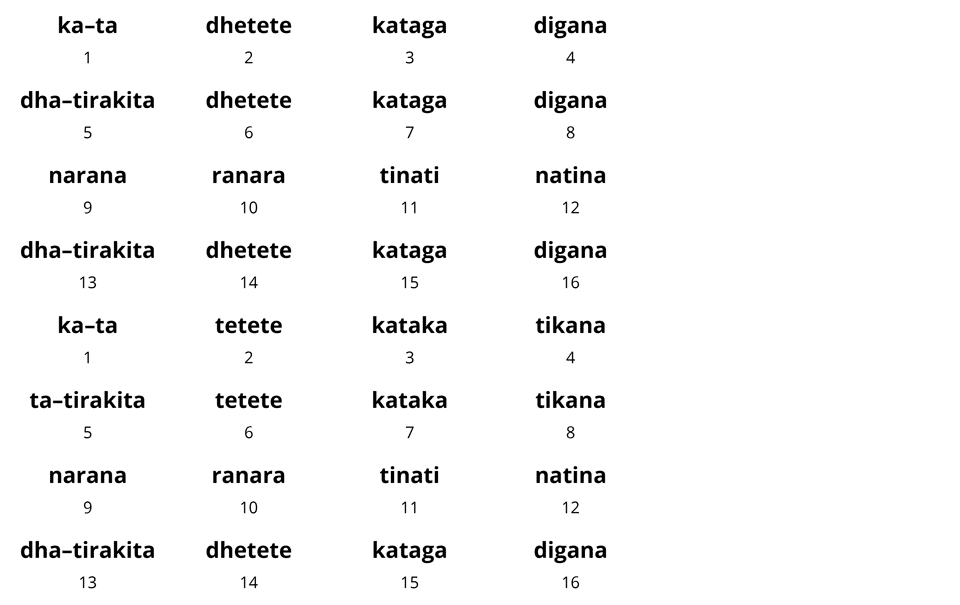
Performed twice:
(from Benares Gat 1)
Introduction to Gat
The gat is a fixed compositional form that is usually performed in tabla solo. In most gharanas, gats are a specialty. And some rare gats are among the most valued compositions in a player’s repertoire. The more advanced gats are often very difficult to play, and require a true master to perform well.
Although gats are now found in all gharanas, they are strongest in the purab gharanas (Lucknow, Farrukhabad, and Benares). Lucknow and Farrukhabad in particular are well known for their rich variety of gats.
Most gats are composed in tintal (16 beat cycle). Although there are gats composed in, or adapted to, other tals, it seems they are less common than other forms in those tals, such as kayda, rela, tukra, or chakradar.
When performed in tabla solo, gats are usually repeated at least twice. They are traditionally played later in a performance at medium or faster tempos.
A Difficult Form to Define
The gat is perhaps the most difficult form to define in the classical tabla repertoire.
In Northern classical music and dance, the term gat means “composition” or “form”. According to some, gat is also related to “movement” or “gait” (gati – गति). And so gat has been used to refer to many different kinds of compositions in tabla, in melodic genres, and in kathak dance.
This partly explains why the gat is not clearly defined: there are simply too many different kinds of compositions called “gat”. Also, in some tabla lineages, some gats and tukras may be very close in form. This surely has added to the confusion about how to define the gat.
Common Gat Characteristics
Because there are so many different kinds of gats, I will discuss only the most common and superficial features below. Although these characteristics are common to Benares gats, they are also common to many gats in other gharanas.
But note that there many gats in Benares and other gharanas which do not share these characteristics.
Many gats have a two-part form
Many gats have a two-part form similar to a kayda: the second half is a repetition of the first half but begins with the khali version (closed bass drum strokes) of the first section.
The example gat given above is a typical example of this. Matras 1–8 of the second half are the khali version of matras 1–8 of the first half (from Benares Gat 1):
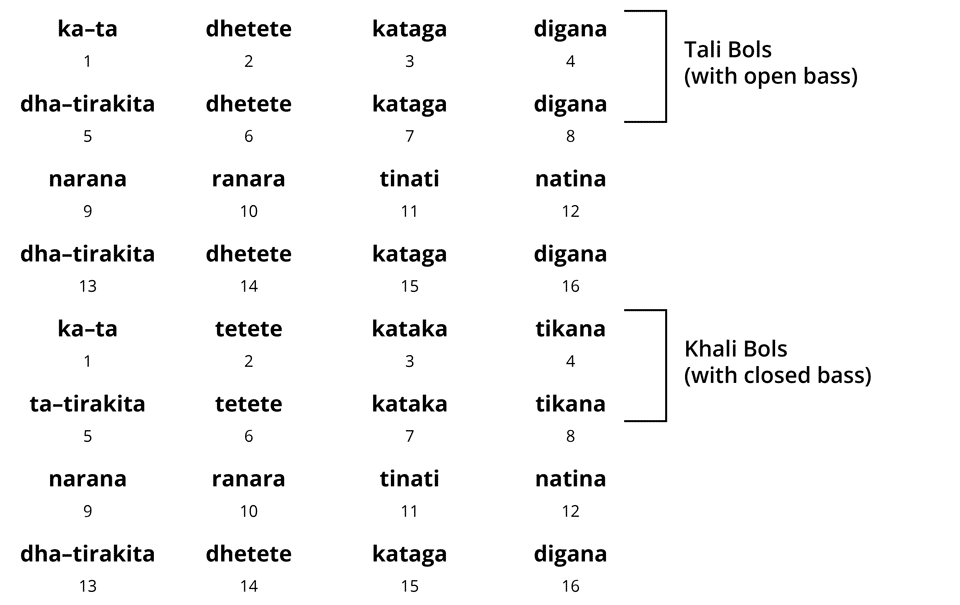
If you are unfamiliar with these bol-pairs, see the section on tali-khali counterparts, and the section on the Structure of Kaydas.
Many gats have multiple lays
Many gats have more than one lay (division of the matra, or “speed”). This could be multiple lays in the composition itself, as in the dupalli, tipalli, and chaupalli gats below. Or it could be performing the entire gat in different lays, as in the darje gat below.
Gats may, or may not, have a tihai
Most gats do not have a tihai. And some players insist that a gat should not have a tihai. However, gats with a tihai are common in all purab gharanas, including Benares.
But even in Benares, not all players agree that a gat may have a tihai. In Francis Shephard’s study of Sharda Sahai and his lineage, she states that a Benares gat may not have a tihai (p. 210). Yet I have learned numerous Benares gats with tihais, some of which are included in Chhotelal’s publications, such as the chaupalli gat below.
This difference of opinion reflects how poorly defined the gat form is, even in the same gharana. Sharda Sahai likely played similar compositions with tihais, but called them by another name.
Common Bols Used in Gats
Because there are so many different kinds of gats, it would be pointless to try and list even the most common bols found in gats across all gharanas. However, some of the most common purab gats do share many similar bols.
Below is a limited sample of bols found in common Benares gats, and in some gats of other purab gharanas:
- ka-tadhetete – कऽतधेतेटे
- katagadigana – कतगदिगन
- dha-tirakitadhe-tete – धाऽतिरकिटधेतेटे
- takita – तकिट
- dha-ra – धाऽड़
- ghinaga – घिनग
- dhagina – धगिन
- dhinagina – धिनगिन
- gheranaga – घेड़नग
- dinataka – दिनतक
- dheradherakitataka – धिरधिरकिटतक
Different Kinds of Gats
Every gharana has a number of different kinds of gats with different names. The example gat given at the beginning of this section is a very well known simple gat (called only “gat”) in Benares. Simple gats which are very similar to this one are common in purab gharanas.
In Benares there are other kinds of gats with names such as dupalli, tipalli, chaupalli, darje, janani, punjabi, lahori, chakradar and others. Other gharanas may also have some of these but will also have different names not found in other gharanas.
Of these gats, I will discuss here only the first four: dupalli, tipalli, chaupalli, and darje gats. These gats are common in Benares, and are similar to ones in other gharanas) and are discussed in the theory section of Chhotelal Misra’s Playing Techniques of Tabla, and in Tal Prabandh.
Dupalli Gat – दुपल्ली गत
A dupalli gat (or dopalli), is a gat which has two different lays (division of the beat). Below is a Benares dupalli gat with divisions of dugun (2:1) and chaugun (4:1). Notice that this gat has the two-part form discussed above where the second half repeats the first half, but with a khali section at the beginning:
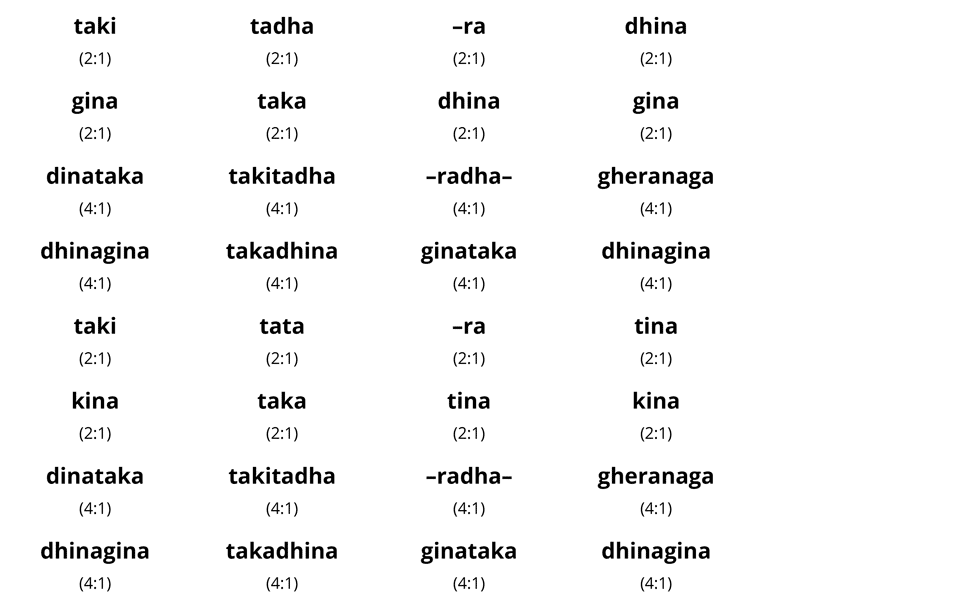
Tipalli Gat – तिपल्ली गत
A tipalli gat is a gat with three different divisions of the beat.
Below is a Benares tipalli gat with divisions of tigun (3:1), chaugun (4:1), and chagun (6:1) (underlined bols are in double speed):
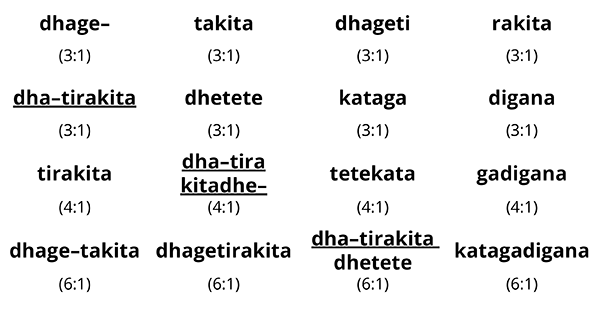
Notice that this gat does not have the common two-part structure, nor is there a khali section at all.
Chaupalli Gat – चौपल्ली गत
A chaupalli gat is a gat with four different divisions of the beat.
Below is a Benares chaupalli gat with divisions of ekgun (1:1), dugun (2:1), tigun (3:1), and atgun (8:1). This gat concludes with a tihai using the phrase dheradherakitataka dha–tirakitataka dha (the phrase kitataka is a fill between tihai repetitions):
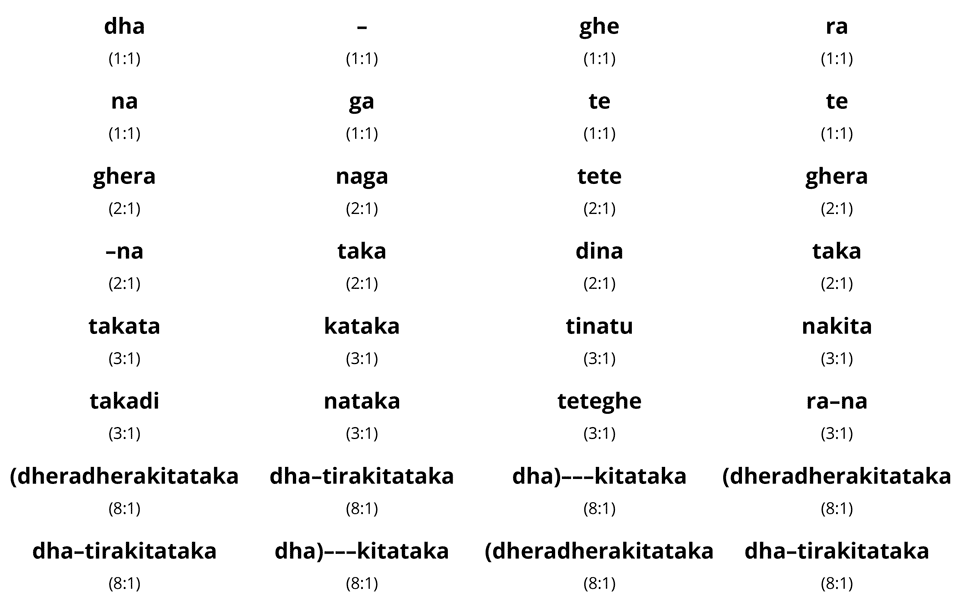
Notice that the last dha of the tihai is not included here. This is because in performance this gat would be repeated multiple times. And so the first dha of the composition would also serve as the last dha of the tihai. Only for the last repetition would an extra dha be added at the end of the tihai.
Darje Gat – दर्जे की गत
A darje gat includes two different versions of the same gat: an aralay version (some division of three: 3:1, 6:1, 12:1, etc.) and a barabar version (even divisions: 2:1, 4:1, 8:1, etc.).
The aralay and barabar versions must be slightly different since the first has odd divisions, while the second has even divisions. As we will see below, the barabar version has a few small bols added to each line.
In a typical performance, each version is played once beginning with the slowest aralay version (usually 3:1), followed by the closest barabar version (4:1). Then the aralay version is doubled (6:1), followed by the barabar version doubled (8:1). Finally, the quadruple speed of the aralay version is played (12:1).
And so the overall sequence of the two versions would be 3:1, 4:1, 6:1, 8:1, 12:1.
Below are the two versions of a Benares darje gat (Benares Gat 2). Versions of this particular gat are also found in other purab gharanas (though not necessarily in two speeds). James Kippen presents a very similar gat in the “The Tabla of Lucknow”, noting that it is believed to be composed by Miyan Bakshu Khan, the founder of the Lucknow gharana (p. 187). Rebecca Stewart also gives a version of this gat, noting that it is from 19th century Lucknow (p. 206)
The first version in 3:1:
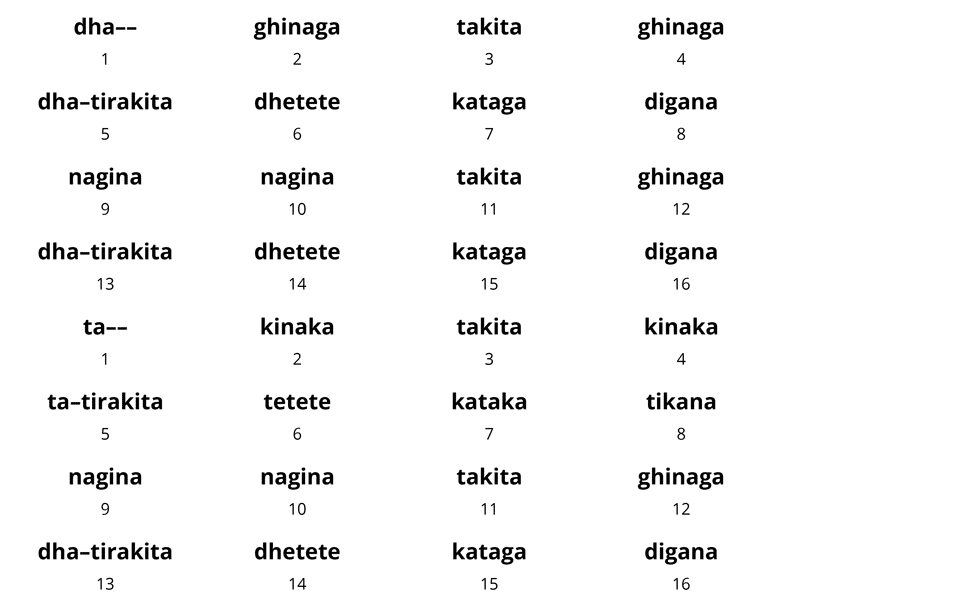
3:1 version performed twice:
The second version is in 4:1. In order to create a 4:1 version of a 3:1 composition, 4 strokes are added to each line. These strokes are underlined:
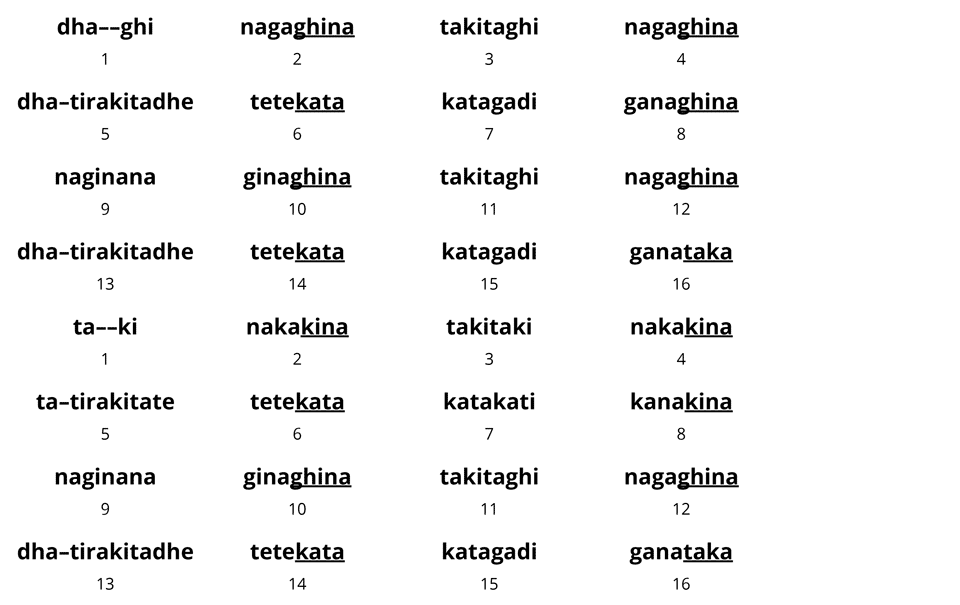
4:1 Version Demonstration (played twice):
Performance of full sequence mentioned above (3:1, 4:1, 6:1, 8:1, 12:1):
Performed with lahra:
References
Kippen, James. The Tabla of Lucknow – A Cultural Analysis of a Musical Tradition. Cambridge: Cambridge University Press, 1988.
Misra, Chhote Lal. Playing Techniques of Tabla – Banaras Gharana. New Delhi: Kanishka Publishers, 2007.
—. Tabla Granth. New Delhi: Kanishka Publishers, 2006. (Hindi)
—. Tal Prabandh. New Delhi: Kanishka Publishers, 2006. (Hindi)
Saxena, Sudhir Kumar. The Art of Tabla Rhythm. New Delhi: D.K. Printworld (P) Ltd., 2006.
Shepherd, Frances Ann. Tabla and the Benares Gharana. Unpublished Ph.D. thesis, Wesleyan University, Middletown Connecticut, 1976.
Stewart, Rebecca Marie. The Tabla in Perspective. Unpublished Ph.D. thesis, University of California, Los Angeles, 1974.
Wegner, Gert-Matthias. Vintage Tabla Repertory – Drum Compositions of North Indian Classical Music. New Delhi: Munshiram Manoharlal Publishers, 2004.